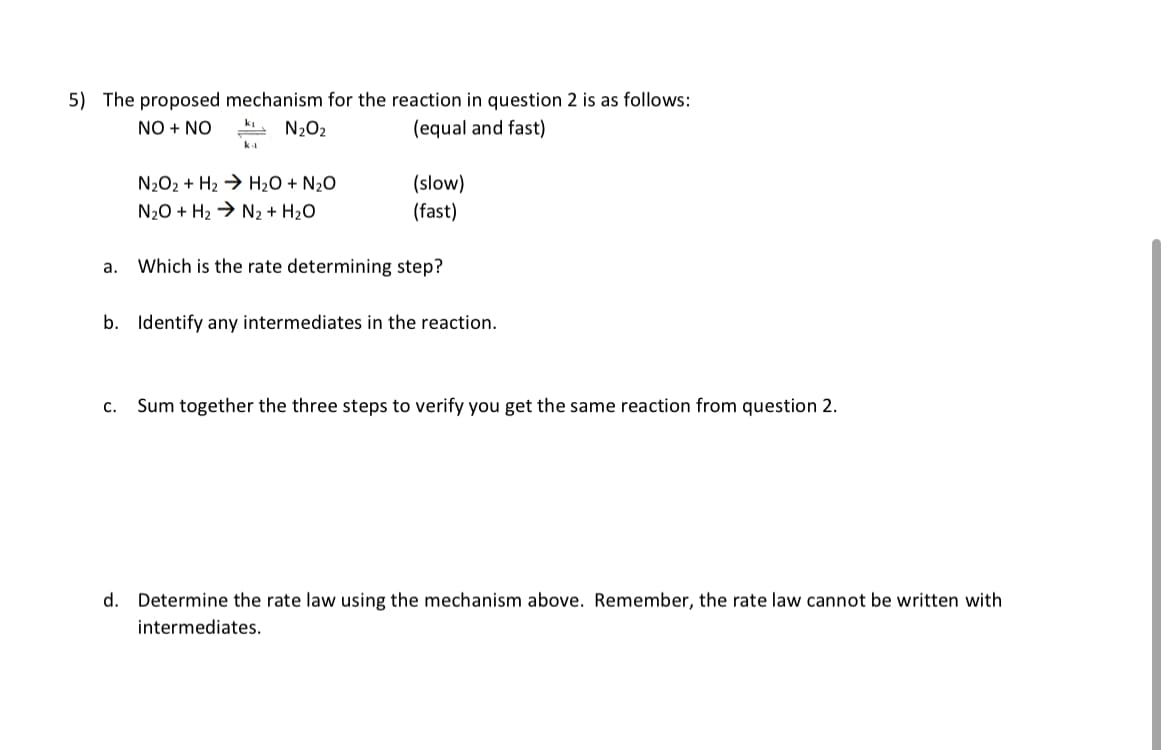5) The proposed mechanism for the reaction in question 2 is as follows: NO + NO N₂O₂ (equal and fast) a. ka C. NzOz + Hz > H2O + N2O N₂O + H₂ → N₂ + H₂O (slow) (fast) Which is the rate determining step? b. Identify any intermediates in the reaction. Sum together the three steps to verify you get the same reaction from question 2. d. Determine the rate law using the mechanism above. Remember, the rate law cannot be written with intermediates.
5) The proposed mechanism for the reaction in question 2 is as follows: NO + NO N₂O₂ (equal and fast) a. ka C. NzOz + Hz > H2O + N2O N₂O + H₂ → N₂ + H₂O (slow) (fast) Which is the rate determining step? b. Identify any intermediates in the reaction. Sum together the three steps to verify you get the same reaction from question 2. d. Determine the rate law using the mechanism above. Remember, the rate law cannot be written with intermediates.
Chemistry for Engineering Students
4th Edition
ISBN:9781337398909
Author:Lawrence S. Brown, Tom Holme
Publisher:Lawrence S. Brown, Tom Holme
Chapter11: Chemical Kinetics
Section: Chapter Questions
Problem 11.96PAE: The following statements relate to the reaction for the formation of HI: H2(g) + I2(g) -* 2 HI(g)...
Related questions
Question
How do you solve explain steps

Transcribed Image Text:5) The proposed mechanism for the reaction in question 2 is as follows:
NO + NO
N₂O₂
(equal and fast)
a.
k₁
C.
N2O2 + Hz ) H2O + N2O
N₂O + H₂ → N₂ + H₂O
(slow)
(fast)
Which is the rate determining step?
b. Identify any intermediates in the reaction.
Sum together the three steps to verify you get the same reaction from question 2.
d. Determine the rate law using the mechanism above. Remember, the rate law cannot be written with
intermediates.
Expert Solution
Step 1
Answer:
Power of concentration term of a reactant in the rate law is the order of reaction with respect to that reactant and overal order of reaction will be the sum of the powers of all concentration terms.
Trending now
This is a popular solution!
Step by step
Solved in 7 steps

Knowledge Booster
Learn more about
Need a deep-dive on the concept behind this application? Look no further. Learn more about this topic, chemistry and related others by exploring similar questions and additional content below.Recommended textbooks for you

Chemistry for Engineering Students
Chemistry
ISBN:
9781337398909
Author:
Lawrence S. Brown, Tom Holme
Publisher:
Cengage Learning

Chemistry & Chemical Reactivity
Chemistry
ISBN:
9781337399074
Author:
John C. Kotz, Paul M. Treichel, John Townsend, David Treichel
Publisher:
Cengage Learning

Chemistry & Chemical Reactivity
Chemistry
ISBN:
9781133949640
Author:
John C. Kotz, Paul M. Treichel, John Townsend, David Treichel
Publisher:
Cengage Learning

Chemistry for Engineering Students
Chemistry
ISBN:
9781337398909
Author:
Lawrence S. Brown, Tom Holme
Publisher:
Cengage Learning

Chemistry & Chemical Reactivity
Chemistry
ISBN:
9781337399074
Author:
John C. Kotz, Paul M. Treichel, John Townsend, David Treichel
Publisher:
Cengage Learning

Chemistry & Chemical Reactivity
Chemistry
ISBN:
9781133949640
Author:
John C. Kotz, Paul M. Treichel, John Townsend, David Treichel
Publisher:
Cengage Learning

Chemistry by OpenStax (2015-05-04)
Chemistry
ISBN:
9781938168390
Author:
Klaus Theopold, Richard H Langley, Paul Flowers, William R. Robinson, Mark Blaser
Publisher:
OpenStax

Chemistry: The Molecular Science
Chemistry
ISBN:
9781285199047
Author:
John W. Moore, Conrad L. Stanitski
Publisher:
Cengage Learning

Chemistry: Principles and Reactions
Chemistry
ISBN:
9781305079373
Author:
William L. Masterton, Cecile N. Hurley
Publisher:
Cengage Learning